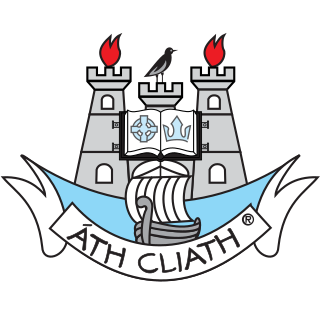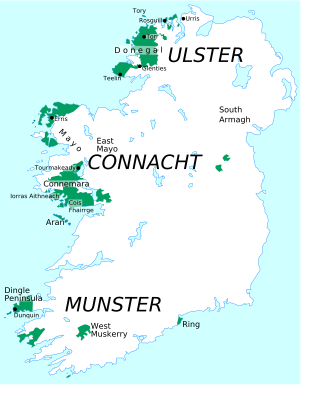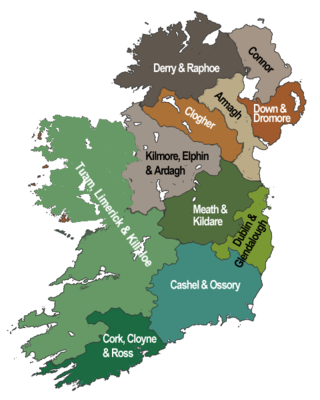This article or section appears to contradict itself.(December 2017) |
Eochy (died 904) [1] was the Irish Archdeacon of Duleek [2] until his death in the late 12th century. [3]
This article or section appears to contradict itself.(December 2017) |
Eochy (died 904) [1] was the Irish Archdeacon of Duleek [2] until his death in the late 12th century. [3]

County Dublin is a county in Ireland, and holds its capital city, Dublin. It is located on the island's east coast, within the province of Leinster. Until 1994, County Dublin was a single local government area; in that year, the county council was divided into three new administrative counties: Dún Laoghaire–Rathdown, Fingal and South Dublin. The four areas form a NUTS III statistical region of Ireland. County Dublin remains a single administrative unit for the purposes of the courts, law enforcement and fire services.

Dublin is the capital and largest city of Ireland. On a bay at the mouth of the River Liffey, it is in the province of Leinster, bordered on the south by the Dublin Mountains, a part of the Wicklow Mountains range. At the 2022 census, the city council area had a population of 592,713, while Dublin City and its suburbs had a population of 1,263,219, and County Dublin had a population of 1,501,500.

Hiberno-English or Irish English (IrE), also formerly sometimes called Anglo-Irish, is the set of English dialects native to the island of Ireland.

Trinity College, officially The College of the Holy and Undivided Trinity of Queen Elizabeth near Dublin, is the sole constituent college of the University of Dublin, a research university in Dublin, Ireland. Queen Elizabeth I issued a royal charter for the college in 1592 as "the mother of a university" that was modelled after the collegiate universities of both Oxford and Cambridge, but unlike these affiliated institutions, only one college was ever established; as such, the designations "Trinity College" and "University of Dublin" are usually synonymous for administrative purposes.

Dublin Castle is a former motte-and-bailey castle and current Irish government complex and conference centre. It was chosen for its position at the highest point of central Dublin.

The Battle of Clontarf took place on 23 April 1014 at Clontarf, near Dublin, on the east coast of Ireland. It pitted an army led by Brian Boru, High King of Ireland, against a Norse-Irish alliance comprising the forces of Sigtrygg Silkbeard, King of Dublin; Máel Mórda mac Murchada, King of Leinster; and a Viking army from abroad led by Sigurd of Orkney and Brodir of Mann. It lasted from sunrise to sunset, and ended in a rout of the Viking and Leinster armies.

Dublin Airport Irish: Aerfort Bhaile Átha Cliath is an international airport serving Dublin, Ireland. It is operated by DAA. The airport is located in Collinstown, 7 km (4.3 mi) north of Dublin, and 3 km (1.9 mi) south of the town of Swords. In 2019, 32.9 million passengers passed through the airport, making it the airport's busiest year on record. It is the 12th busiest airport in Europe, and is the busiest of Ireland's airports by total passenger traffic; it also has the largest traffic levels on the island of Ireland, followed by Belfast International Airport.
Events from the year 1924 in Ireland.

Vikings invaded the territory around Dublin in the 9th century, establishing the Norse Kingdom of Dublin, the earliest and longest-lasting Norse kingdom in Ireland. Its territory corresponded to most of present-day County Dublin. The Norse referred to the kingdom as Dyflin, which is derived from Irish Dubh Linn 'black pool'. The first reference to the Vikings comes from the Annals of Ulster and the first entry for 841 AD reads: "Pagans still on Lough Neagh". It is from this date onward that historians get references to ship fortresses or longphorts being established in Ireland. It may be safe to assume that the Vikings first over-wintered in 840–841 AD. The actual location of the longphort of Dublin is still a hotly debated issue. Norse rulers of Dublin were often co-kings, and occasionally also Kings of Jórvík in what is now Yorkshire. Under their rule, Dublin became the biggest slave port in Western Europe. The hinterland of Dublin in the Norse period was named in Old Norse: Dyflinnar skíði, lit. 'Dublinshire'.

The Dublin County Board of the Gaelic Athletic Association (GAA) or Dublin GAA is one of the 32 county boards of the GAA in Ireland, and is responsible for Gaelic games in County Dublin and the Dublin county teams. The teams and their fans are known as "The Dubs" or "Boys in Blue". The fans have a special affiliation with the Hill 16 end of Croke Park.

Connacht Irish is the dialect of the Irish language spoken in the province of Connacht. Gaeltacht regions in Connacht are found in Counties Mayo and Galway. Connacht Irish is also spoken in the Meath Gealtacht Ráth Chairn and Baile Ghib. The dialects of Irish in Connacht are extremely diverse, with the pronunciation, forms and lexicon being different even within each county.

Munster Irish is the dialect of the Irish language spoken in the province of Munster. Gaeltacht regions in Munster are found in the Gaeltachtaí of the Dingle Peninsula in west County Kerry, in the Iveragh Peninsula in south Kerry, in Cape Clear Island off the coast of west County Cork, in Muskerry West; Cúil Aodha, Ballingeary, Ballyvourney, Kilnamartyra, and Renaree of central County Cork; and in an Rinn and an Sean Phobal in Gaeltacht na nDéise in west County Waterford.

The United Provinces of Dublin and Cashel, commonly called the Province of Dublin, and also known as the Southern Province, is one of the two ecclesiastical provinces that together form the Church of Ireland; the other is the Province of Armagh. The province has existed since 1833 when the ancient Province of Dublin was merged with the Province of Cashel. Its metropolitan bishop is the Archbishop of Dublin.
Events from the year 1789 in Ireland.
Events from the year 1733 in Ireland.
Events from the year 1670 in Ireland.

The Archbishop of Dublin is an archiepiscopal title which takes its name from Dublin, Ireland. Since the Reformation, there have been parallel apostolic successions to the title: one in the Catholic Church and the other in the Church of Ireland. The archbishop of each denomination also holds the title of Primate of Ireland.
Events from the year 1663 in Ireland.
Events from the year 1637 in Ireland.
Events from the year 1521 in Ireland.